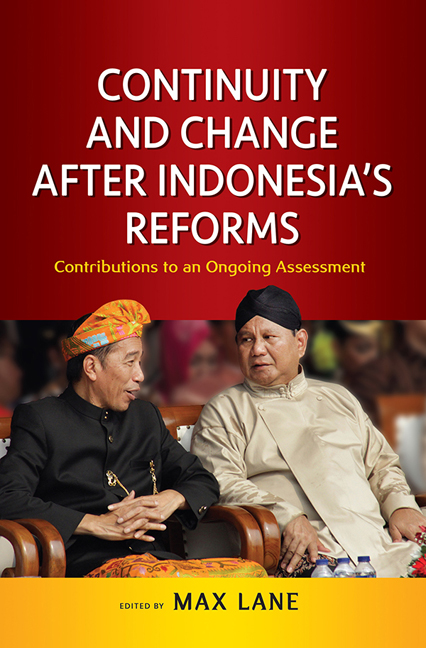Book contents
- Frontmatter
- Contents
- Preface
- About the Contributors
- 1 Indonesia's New Politics: Transaction Without Contestation
- 2 Indonesian Parties Twenty Years On: Personalism and Professionalization amidst Dealignment
- 3 Ideologies of Joko Widodo and Indonesian Political Parties
- 4 Political Islam Movements and Democracy in Indonesia: A Changing Landscape?
- 5 Creating Leadership Legitimacy in Post-Reform Indonesia
- 6 The Political Middle Class in Post-Soeharto Era Indonesia
- 7 The Politics of Centre–Local Relations in Contemporary Indonesia
- 8 The Roots and Actors of Corruption in the Political Realm
- 9 Why Is It Really Hard to Move On? Explaining Indonesia's Limited Foreign Policy Reform After Soeharto
- 10 Papua under the Joko Widodo Presidency
- 11 Youth “Alienation” and New Radical Politics: Shifting Trajectories in Youth Activism
- Index
1 - Indonesia's New Politics: Transaction Without Contestation
Published online by Cambridge University Press: 06 September 2019
- Frontmatter
- Contents
- Preface
- About the Contributors
- 1 Indonesia's New Politics: Transaction Without Contestation
- 2 Indonesian Parties Twenty Years On: Personalism and Professionalization amidst Dealignment
- 3 Ideologies of Joko Widodo and Indonesian Political Parties
- 4 Political Islam Movements and Democracy in Indonesia: A Changing Landscape?
- 5 Creating Leadership Legitimacy in Post-Reform Indonesia
- 6 The Political Middle Class in Post-Soeharto Era Indonesia
- 7 The Politics of Centre–Local Relations in Contemporary Indonesia
- 8 The Roots and Actors of Corruption in the Political Realm
- 9 Why Is It Really Hard to Move On? Explaining Indonesia's Limited Foreign Policy Reform After Soeharto
- 10 Papua under the Joko Widodo Presidency
- 11 Youth “Alienation” and New Radical Politics: Shifting Trajectories in Youth Activism
- Index
Summary
The period between 1998 and 2014 in Indonesian politics was defined by a political project necessitated by the fall of Soeharto in 1998 and the end of a specific form of political rule: dictatorship. May 1998 did not mark only the end of the overwhelming power of a specific individual – Soeharto – but at the same time the demolition of the whole structure of political rule that existed at that time. Between 1965 and 1998, and especially from 1972, political power had become centralized in one man, with structures that gave reality to that. These included a national military structure and ideology that both gave the army a physical presence at every level of administration, from national to village, and openly legitimized a repressive role for the army in politics. As president, Soeharto was Supreme Commander of the Armed Forces, backed by a loyal network of officers originating from the time when he was still an active officer himself. This centralized mechanism of repression and control was paralleled by a semi-theatrical electoral and representative structure, in which only three political parties, selected by Soeharto, were allowed and in which the repressive apparatus was able to intervene to determine the personnel and policies of all three. The press and civil society were severely restricted.
Following a complicated evolution and growth of an opposition, even in the face of this repression and at some cost to life and liberty, Soeharto was forced to resign. The removal of the linchpin of the system in the face of popular opposition forced a broad coalition of elite politicians and groups that filled the vacuum left by his departure to concede to the demand for political reform. The military's role in repression stopped (except in the provinces of Papua). The electoral and representative system was opened up to more parties — essentially only communist and separatist parties were banned. Most restrictions of the press and civil society were lifted.
The dismantling of the structures of dictatorship required replacement structures. The primary structure that has become the scaffolding of the present system is the electoral and representative systems. Which groups control the national and local government apparatus is now processed through elections.
- Type
- Chapter
- Information
- Continuity and Change after Indonesia's ReformsContributions to an Ongoing Assessment, pp. 1 - 21Publisher: ISEAS–Yusof Ishak InstitutePrint publication year: 2019



